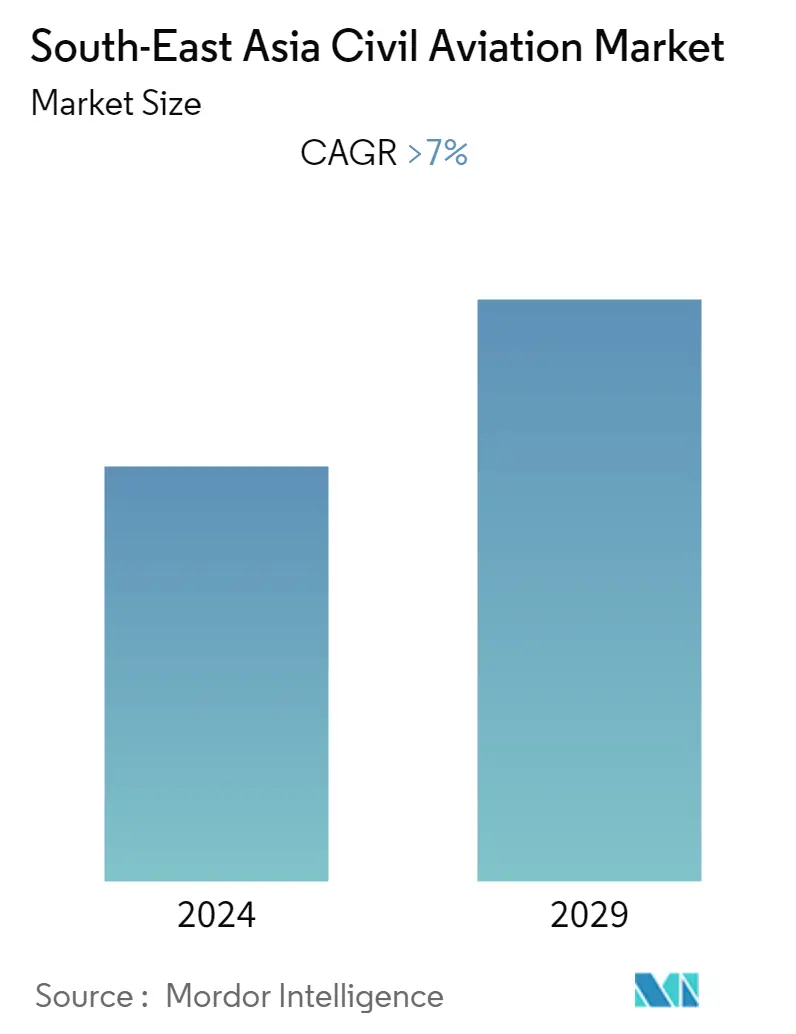Market Size of South-East Asia Civil Aviation Industry

| Study Period | 2020 - 2029 |
| Base Year For Estimation | 2023 |
| Forecast Data Period | 2024 - 2029 |
| Historical Data Period | 2020 - 2022 |
| CAGR | > 7.00 % |
| Market Concentration | High |
Major Players
*Disclaimer: Major Players sorted in no particular order |
South-East Asia Civil Aviation Market Analysis
The South-East Asia civil aviation market is expected to register a CAGR of over 7% during the forecast period.
- The COVID-19 pandemic presented unprecedented challenges for the aviation sector, including in South-East Asian countries. The region has experienced a significant decline in the number of travelers, reduced demand for aircraft, and supply chain disruptions. For instance, in Indonesia, the Ministry of Transportation reported a decline in the number of airplane passengers from 117 million in 2019 to 43 million in 2020. This trend continued into 2021, with only 35 million air passengers.
- However, the aviation sector has shown signs of recovery as governments ease travel restrictions. According to the Ministry of Indonesia, the number of air travelers in 2022 reached 78 million, indicating a positive outlook for the industry.
- Several factors, including an increase in air passengers, rising tourism expenditure, and growing demand for commercial aircraft fuel the market growth in the region. Additionally, the growth in air freight transport and demand for business jets from individuals are driving the market growth.
- Despite the pandemic, Vietnam's air cargo industry experienced strong growth, with a 17% increase in air cargo traffic in 2022, reaching 1.52 million tons. This growth can be attributed to the increasing tourism and spending in the aviation sector from Southeast Asian countries.
- In summary, the aviation sector in South-East Asian countries has faced significant challenges due to the COVID-19 pandemic, but the industry is showing signs of recovery. Factors such as increasing air passengers, rising tourism expenditure, and growing demand for aircraft and business jets are driving market growth in the region.
South-East Asia Civil Aviation Industry Segmentation
Civil aviation includes commercial air transport such as scheduled and non-scheduled passengers and cargo aircraft. It also covers the aircraft used for specialized services such as photography, search and rescue, agriculture, surveying, and others.
The Southeast Asia civil aviation market is segmented based on aircraft type and country. By aircraft type, the market is segmented into commercial aircraft and general aviation aircraft. The commercial aircraft segment is further divided into passenger aircraft and freighter aircraft. The general aviation segment is further classified as helicopters, business jets, turboprop aircraft, and piston aircraft. By geography, the market is segmented into Indonesia, Malaysia, Singapore, Thailand, the Philippines, and others.
The market sizing and forecasts have been provided in value (USD billion) for all the above segments.
| Aircraft Type | ||||||
| ||||||
|
| Geography | |
| Singapore | |
| Thailand | |
| Indonesia | |
| Malaysia | |
| Philippines | |
| Rest of South-East Asia |
South-East Asia Civil Aviation Market Size Summary
The South-East Asia civil aviation market is poised for significant growth, driven by a resurgence in air travel and increasing demand for commercial aircraft. The sector is recovering from the challenges posed by the COVID-19 pandemic, which had led to a substantial decline in air traffic and disruptions in supply chains. As travel restrictions ease, the region is witnessing a rebound in passenger numbers and a surge in international flight bookings, particularly in countries like the Philippines and Thailand. This recovery is further supported by rising tourism expenditure and the expansion of air freight transport. The construction of new airports and the demand for new passenger aircraft are expected to bolster market growth, with Indonesia leading the charge due to its extensive network of airports and robust tourism sector.
The commercial aircraft segment in South-East Asia is set for remarkable expansion, fueled by increasing air traffic and investment in the aviation sector. Key players in the market, such as Airbus, Boeing, and Embraer, are actively engaging in strategies like mergers, acquisitions, and long-term contracts to strengthen their market position. Indonesia, with its ambitious plans for airport construction and environmentally friendly aviation initiatives, is a dominant force in the region. The country's commitment to developing sustainable aviation fuels and expanding its aircraft fleet underscores its potential to become a major player in the global aviation market. As the region continues to recover and grow, the civil aviation industry in South-East Asia is expected to experience robust development, driven by both passenger and cargo demand.
South-East Asia Civil Aviation Market Size - Table of Contents
-
1. MARKET DYNAMICS
-
1.1 Market Overview
-
1.2 Market Drivers
-
1.3 Market Restraints
-
1.4 Porter's Five Forces Analysis
-
1.4.1 Bargaining Power of Buyers/Consumers
-
1.4.2 Bargaining Power of Suppliers
-
1.4.3 Threat of New Entrants
-
1.4.4 Threat of Substitute Products
-
1.4.5 Intensity of Competitive Rivalry
-
-
-
2. MARKET SEGMENTATION
-
2.1 Aircraft Type
-
2.1.1 Commercial Aircraft
-
2.1.1.1 Passenger Aircraft
-
2.1.1.2 Freighter Aircraft
-
-
2.1.2 General Aviation
-
2.1.2.1 Business Jet
-
2.1.2.2 Helicopters
-
2.1.2.3 Piston Fixed-Wing Aircraft
-
2.1.2.4 Turboprop Aircraft
-
-
-
2.2 Geography
-
2.2.1 Singapore
-
2.2.2 Thailand
-
2.2.3 Indonesia
-
2.2.4 Malaysia
-
2.2.5 Philippines
-
2.2.6 Rest of South-East Asia
-
-
South-East Asia Civil Aviation Market Size FAQs
What is the current South-East Asia Civil Aviation Market size?
The South-East Asia Civil Aviation Market is projected to register a CAGR of greater than 7% during the forecast period (2024-2029)
Who are the key players in South-East Asia Civil Aviation Market?
Airbus S.A.S, The Boeing Company, Embraer SA, Bombardier Inc. and ATR are the major companies operating in the South-East Asia Civil Aviation Market.

